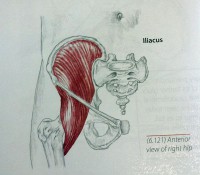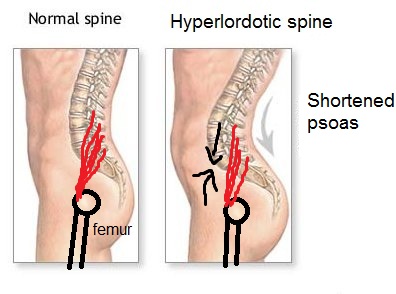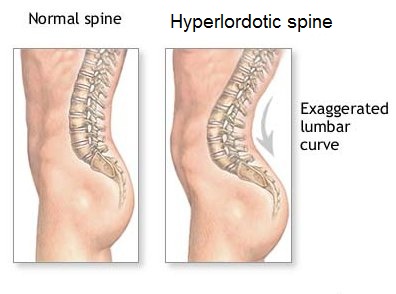Mondays are dedicated to female training. Today’s post also applies to males.
Hyperlordosis is a condition in which normal lordosis, or curvature in the lumbar spine, is over exaggerated and severe to the point that there is damage to the spine or it is limiting to properly executing a given movement.
This can be an over extension in the lumbar spine itself, an over extension in the lumbar/sacral junction, or possibly even an over extension of the thoracic/lumbar junction. If you are unfamiliar with these terms, edumicate yourself with this picture. Women are stereotypically hyperlordotic, yet this issue effects a lot of guys as well.
Hyperlordosis is a problem in athletic movement, including lifting, because it alters mechanics and excessively loads the spine to increase the chance of injury. If the injury doesn’t occur in an acute instance, then poor mechanics will weaken the structure(s) over time to the point that a sub-maximal or meaningless act causes the structure to fail (more on this concept). This is how people get injured by tying their shoes, picking up their dog, or sneezing.
The cause of hyperlordosis is having short hip flexors. It should be no surprise that this is the case since most people in Western society spend at least several hours sitting down with their hip flexed every day (don’t know “hip flexion”? Review anatomical movements here). There are many muscles involved in hip flexion, including the glutes and adductors, yet primarily include the rectus femoris, sartorius, TFL, and, most importantly, the iliopsoas.
 The “iliopsoas” is a conglomerate of the psoas major and iliacus, and it’s important to know where they attach to understand why they cause hyperlordosis when they are chronically shortened. Note that we typically just say “the psoas” because only about 40% of the population has a psoas minor — it’s a muscle that still lingers, evolutionary speaking, from our quadruped counterparts (i.e. your dog or cat has one).
The “iliopsoas” is a conglomerate of the psoas major and iliacus, and it’s important to know where they attach to understand why they cause hyperlordosis when they are chronically shortened. Note that we typically just say “the psoas” because only about 40% of the population has a psoas minor — it’s a muscle that still lingers, evolutionary speaking, from our quadruped counterparts (i.e. your dog or cat has one).
 The psoas attaches on the transverse processes (bony protrusions on the site) of the lumbar vertebrae and the lesser trochanter (small bump) on the inside, and sort of in towards the rear, of the femur. The iliacus attaches on the iliac fossa (large, smooth area on the inside of the ilium, which is part of the pelvis) down to the same lesser trochanter.
Now that you know where the muscles are, imagine what happens when they shorten. The distance between the top and bottom attachments will decrease. This happens during leg raises or sit-ups with the feet supported. It also happens when you sit. Now imagine that you sit so much that this shortened distance adapts to being shortened and remains shortened. When you stand back up, the distance will remain the same, and this pulls the top attachments down towards the femur. Since the top attachments are either the pelvis or the lumbar vertebrae, it hyper-extends these two areas. Read this again: the top attachments of the psoas are pulled down to the femur when they are chronically shortened.
The psoas attaches on the transverse processes (bony protrusions on the site) of the lumbar vertebrae and the lesser trochanter (small bump) on the inside, and sort of in towards the rear, of the femur. The iliacus attaches on the iliac fossa (large, smooth area on the inside of the ilium, which is part of the pelvis) down to the same lesser trochanter.
Now that you know where the muscles are, imagine what happens when they shorten. The distance between the top and bottom attachments will decrease. This happens during leg raises or sit-ups with the feet supported. It also happens when you sit. Now imagine that you sit so much that this shortened distance adapts to being shortened and remains shortened. When you stand back up, the distance will remain the same, and this pulls the top attachments down towards the femur. Since the top attachments are either the pelvis or the lumbar vertebrae, it hyper-extends these two areas. Read this again: the top attachments of the psoas are pulled down to the femur when they are chronically shortened.
 This is why you’ll never fully integrate your hips into any jumping movement. This is why you’ll hurt your back in pulling exercises. This is why your erectors won’t increase to be big pork loins (bread loaves aren’t meaty enough). This is why you don’t have a straight trunk on the press. This is one reason why your overhead position sucks. This is why your back hurts anywhere from the bottom of your scapula to your glutes. This is also a contributing factor to you walking with your feet pointed out (i.e. like a lazy bastard).
Treating The Muscles
Knowing where the muslces are is necessary because we’ll need to massage them in order to help “un-shorten” them by reducing their tension. Simply doing something like the couch stretch will help open some of the other hip flexors, but overall is inadequate to reducing tension on the psoas. You may have seen this type of treatment, but if you’re going in blind you may not actually hit the intended area. And you could occlude the abdominal aorta if you’re a belligerent goober — if you feel a pulse when trying to massage your left psoas, then move a bit laterally to avoid it.
To begin, lie on your back, pull your knees up, and let them fall to the side opposite to the posas you want to work on. This will let your intestines move away from the target area. Start about two inches from your belly button — you’ll be between the button and your hip bone. You are feeling around for a muscle that runs longitudinally with your spine. If you are incredibly tight, it can feel like a hard sausage. To confirm that you are touching your psoas, flex your hip (pull your knee up) slightly; the psoas should contract. Another way is to lift your head to contract your rectus abdominis; the psoas will be off to the side of the area that contracts. It may take a few minutes to become acquainted with the psoas your first time; be patient, virgin.
Use all four of your fingers together to massage the psoas. You can move laterally across the fibers and then along the muscle belly (vertically with your spine) when you are familiar with the psoas’ location. If you are particularly tight, even light pressure will be near unbearable (and probably make you feel sick). Stroke the fibers and continue moving down the psoas towards the hip itself. The more you can massage, the more tension you’ll release. Use short deliberate strokes, preferably in one way. Accumulate about 10 to 15 strokes on one spot and then move on down the muscle belly. Check from below your lowest ribs all the way to the groin/hip area.
The iliacus can also be massaged from this position. Just stick your thumb inside of your hip bone (the anterior superior iliac spine, ASIS) and work the inside wall of the iliac fossa. Most of your attention will be on the psoas, but a few seconds on the iliacus will only help.
What Else Should You Do
If you have a problem with hyperlordosis, then it probably has developed over a long period of time. Sitting down a lot, bad mechanics, trying to over correct posture, trying to do lower ab work with hyperlordosis, trying to stick your ass out (girls), or trying to puff your chest up (guys) will cause tightness in the hip flexors. Stop sitting. Stop sleeping with your hips flexed. Open your hip flexors with couch stretching, anterior band distraction on the proximal hip, and lunge stretching (Mark Verstegen’s “perfect stretch” works). The lunge stretch is effective if you push your groin to the ground and laterally flex and slightly rotate the trunk away from the back leg’s side (it can stretch the psoas a bit). Keep the lower abs tight on any hip flexor stretch. This is imperative. Otherwise you’re just going to go into hyperlordosis and not stretch anything.
Use the stretches after manually working on the psoas. Soft tissue work should always precede positional stretching since it will help relieve tension on the muscle before actually stretching it. Soft tissue work can be done multiple times a day — and it should be if you have a bad case of hyperlordosis. Spending a minute on each psoas up to ten times a day if you are crusty.
Note that abdominal work, especially on the lower abs, while in hyperlordosis will only make the problem worse. Many people will say, “Well, I’m doing leg lifts and GHD sit-ups to strengthen my abs,” but they are just training their hip flexors by contracting them, which will only help shorten them even more. Use abdominal exercises that don’t anchor the feet. People tell me the “hollow rock” is effective for people with hyperlordosis.
The Doorway Method
This is why you’ll never fully integrate your hips into any jumping movement. This is why you’ll hurt your back in pulling exercises. This is why your erectors won’t increase to be big pork loins (bread loaves aren’t meaty enough). This is why you don’t have a straight trunk on the press. This is one reason why your overhead position sucks. This is why your back hurts anywhere from the bottom of your scapula to your glutes. This is also a contributing factor to you walking with your feet pointed out (i.e. like a lazy bastard).
Treating The Muscles
Knowing where the muslces are is necessary because we’ll need to massage them in order to help “un-shorten” them by reducing their tension. Simply doing something like the couch stretch will help open some of the other hip flexors, but overall is inadequate to reducing tension on the psoas. You may have seen this type of treatment, but if you’re going in blind you may not actually hit the intended area. And you could occlude the abdominal aorta if you’re a belligerent goober — if you feel a pulse when trying to massage your left psoas, then move a bit laterally to avoid it.
To begin, lie on your back, pull your knees up, and let them fall to the side opposite to the posas you want to work on. This will let your intestines move away from the target area. Start about two inches from your belly button — you’ll be between the button and your hip bone. You are feeling around for a muscle that runs longitudinally with your spine. If you are incredibly tight, it can feel like a hard sausage. To confirm that you are touching your psoas, flex your hip (pull your knee up) slightly; the psoas should contract. Another way is to lift your head to contract your rectus abdominis; the psoas will be off to the side of the area that contracts. It may take a few minutes to become acquainted with the psoas your first time; be patient, virgin.
Use all four of your fingers together to massage the psoas. You can move laterally across the fibers and then along the muscle belly (vertically with your spine) when you are familiar with the psoas’ location. If you are particularly tight, even light pressure will be near unbearable (and probably make you feel sick). Stroke the fibers and continue moving down the psoas towards the hip itself. The more you can massage, the more tension you’ll release. Use short deliberate strokes, preferably in one way. Accumulate about 10 to 15 strokes on one spot and then move on down the muscle belly. Check from below your lowest ribs all the way to the groin/hip area.
The iliacus can also be massaged from this position. Just stick your thumb inside of your hip bone (the anterior superior iliac spine, ASIS) and work the inside wall of the iliac fossa. Most of your attention will be on the psoas, but a few seconds on the iliacus will only help.
What Else Should You Do
If you have a problem with hyperlordosis, then it probably has developed over a long period of time. Sitting down a lot, bad mechanics, trying to over correct posture, trying to do lower ab work with hyperlordosis, trying to stick your ass out (girls), or trying to puff your chest up (guys) will cause tightness in the hip flexors. Stop sitting. Stop sleeping with your hips flexed. Open your hip flexors with couch stretching, anterior band distraction on the proximal hip, and lunge stretching (Mark Verstegen’s “perfect stretch” works). The lunge stretch is effective if you push your groin to the ground and laterally flex and slightly rotate the trunk away from the back leg’s side (it can stretch the psoas a bit). Keep the lower abs tight on any hip flexor stretch. This is imperative. Otherwise you’re just going to go into hyperlordosis and not stretch anything.
Use the stretches after manually working on the psoas. Soft tissue work should always precede positional stretching since it will help relieve tension on the muscle before actually stretching it. Soft tissue work can be done multiple times a day — and it should be if you have a bad case of hyperlordosis. Spending a minute on each psoas up to ten times a day if you are crusty.
Note that abdominal work, especially on the lower abs, while in hyperlordosis will only make the problem worse. Many people will say, “Well, I’m doing leg lifts and GHD sit-ups to strengthen my abs,” but they are just training their hip flexors by contracting them, which will only help shorten them even more. Use abdominal exercises that don’t anchor the feet. People tell me the “hollow rock” is effective for people with hyperlordosis.
The Doorway Method
I read a communication book that it helps to re-position your posture when going through a doorway. It gave the example that you’re reaching up slightly with your mouth to bite a piece of leather. The idea is that it would raise your chin and shoulders, and pull the lips slightly lateral, like a smile, before entering a room. A confident, happy person gives a much better impression than an internally rotated, deflated pussy. If a person did this when they passed through every door, then they get up to 30 reps a day of not looking like a loser. I like to use this same method for postural corrections in mobility.
If you know you have bad posture, whether it’s hyperlordosis or slouched, internally rotated (i.e. pussy) shoulders, then start realigning yourself every time you pass through a doorway. Not only will it be a constant reminder for good posture, but you’ll get consistent reps every day.
“Good posture” has the lower abs tight with the shoulders back. Don’t over-exaggerate the “chest up” and “shoulders back” thing; be natural, not a Tommy Tough Guy.
Consistency
It’s important to note that any mobility issue most likely has developed by doing something wrong for a very long time. I always tell people, “The longer it takes for something to develop, the longer it’ll take to eradicate it.” Be consistent in working on your hyperlordosis. That means work on it daily, multiple times a day. If you only have a limited amount of time to train, be sure to put an emphasis on your mobility. If you ignore it and a) get injured or b) perform crappy because of it, then all of that bad training was an inefficient use of your time.
